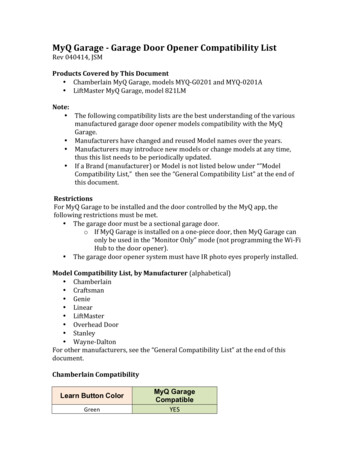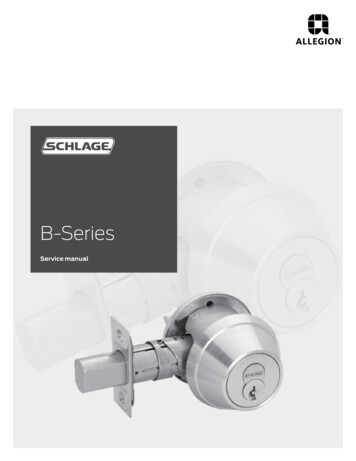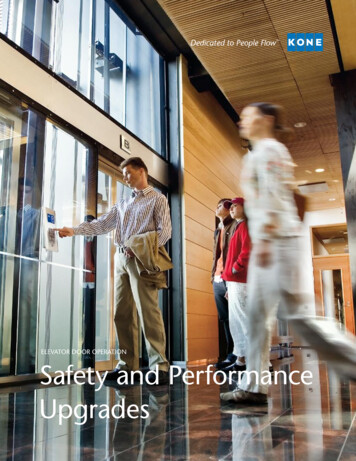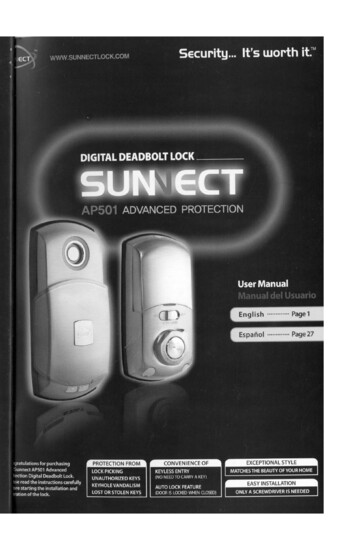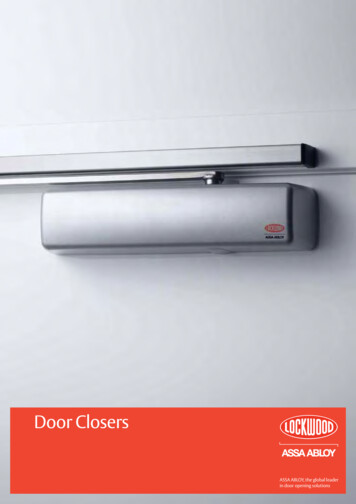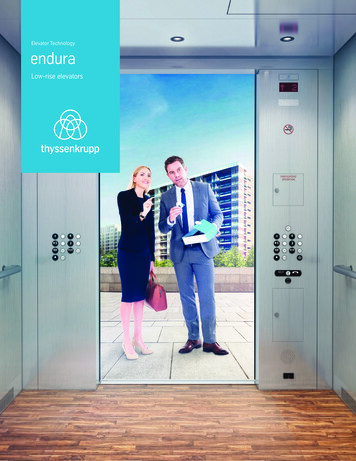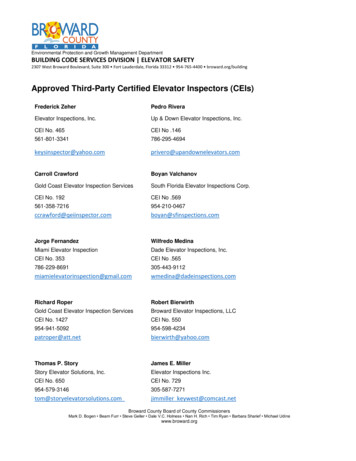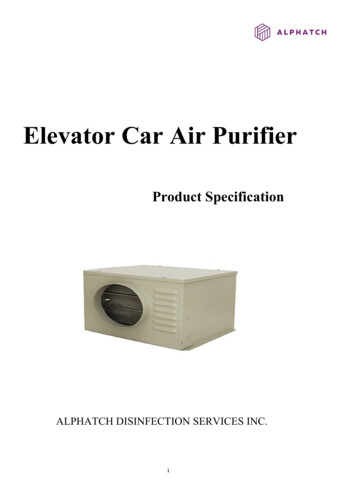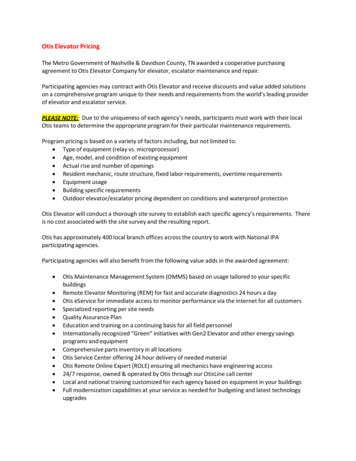
Transcription
12020 DIGITAL: SAFETY, INNOVATION &SUSTAINABILITY CONFERENCEELEVATORDOOR LOCKMONITORING &ENERGY CODECOMPLIANCEPRESENTED BYCharanjeet Singh, PEDonald Franklin
COPYRIGHT MATERIALSThis presentation is protected by US and InternationalCopyright laws. Reproduction, distribution, displayand use of the presentation without writtenpermission of the speaker is prohibited. 2020 New York City Department of Buildings2020 DIGITAL: SAFETY, INNOVATION & SUSTAINABILITY CONFERENCE
PRESENTATION DESCRIPTIONThis presentation provides an overview of Elevator Door Lockmonitoring and Energy Code compliance. During this courseparticipants will learn about door lock monitoring requirementsand the Departments’ enforcement strategy for non-compliancewith this retroactive requirement. Additionally, the Energy Coderequirements for escalators and moving walks to reduce speedwhen not conveying passengers is provided.2020 DIGITAL: SAFETY, INNOVATION & SUSTAINABILITY CONFERENCE3
OVERVIEW: ELEVATORS IN NEW YORK CITY 150 . Years of Elevator History (since 1857) 90K .Devices Under the DOB Jurisdiction 500 .Average Daily Elevator Trips 45 Million .Daily Citywide Trips 12%.Percentage of all Elevators in NYC2020 DIGITAL: SAFETY, INNOVATION & SUSTAINABILITY CONFERENCE4
TYPES OF DEVICESElevator Devices2020 DIGITAL: SAFETY, INNOVATION & SUSTAINABILITY CONFERENCE5
FUNCTIONS OF THE ELEVATOR UNITPlan onAuditsElevatorUnitAmusementRide pections2020 DIGITAL: SAFETY, INNOVATION & SUSTAINABILITY CONFERENCESurveys6
ELEVATOR REFERENCE CODESCodeDescriptionIBC 2009 as modified by NYC Building Code 2014 - Elevators and Conveying Systems Chapter 30ICC/ANSI A117.1 – 2009Accessible and usable buildings and facilitiesASME A17.1/2000 with supplements A17.1a – 02 and A17.1b– 03Safety code for Elevators and Escalators as modified by NYC Building Code Appendix K;Chapter K1ASME A17.1s – 2005Supplement to Safety Code for Elevator and Escalator for Machine Room Less (MRL)elevators as modified by Appendix K; Chapter K4ASME A17.2 - 2002Guide for Inspection of Elevators, Escalators and Moving WalkASME A17.3 - 2002Safety Code For Existing Elevators and Escalators as modified by Appendix K; Chapter K3ASME A17.5 – 2004Elevator and escalator electrical equipmentASME A17.6 – 2010Standard for Elevator Suspension, Compensation, and Governor Systems as modified byAppendix K; Chapter K4ANSI A10.4 - 1981Personnel Hoists and Employee Elevators on Construction and Demolition SitesANSI A10.4 - 2007**Device Operator requirements onlyASME A18.1 – 2005Safety Standard for Platform Lifts and Stairway ChairliftsB20.1—2006Safety Standard for Conveyors and Related Equipment2020 DIGITAL: SAFETY, INNOVATION & SUSTAINABILITY CONFERENCE7
CODE COMMITTEESAFFILIATION/REPRESENTATION NYC Elevator Code Committeeconsist of elevator stakeholdergroups, organizations,associations and governmentagencies.NEII - National Elevator Industry, Inc.NYCHA – New York City Housing AuthorityREBNY - Real Estate Board of New YorkECNY – Elevator Conference of NYPort Authority of NY & NJEMANY – Elevator Manufacturers Association ofNYFDNY - New York City Fire DepartmentASME - Code Committee MemberBOMA – Buildings Owners and ManagersAssociation of NYLocal Union – 1, 3NYC - DOB – New York City Department ofBuildingsNAEC - National Association of ElevatorContractorsDCAS - Department of Citywide AdministrativeServices2020 DIGITAL: SAFETY, INNOVATION & SUSTAINABILITY CONFERENCE Committee reviews each sectionof the Code and standards andmakes decisions to enhance thesafe and reliable service for ourriders. Committee uses consensusbased process.8
ELEVATOR SAFETYThe yResponders2020 DIGITAL: SAFETY, INNOVATION & SUSTAINABILITY CONFERENCE9
DOOR LOCK MONITORING3.10.12 System to monitor and preventautomatic operation of passengerand freight elevators with faulty doorcontact circuits2020 DIGITAL: SAFETY, INNOVATION & SUSTAINABILITY CONFERENCE10
DOOR LOCK MONITORING All automatic passenger and freight elevators must comply. Compliance date: January 1, 2020. A permit is always required.2020 DIGITAL: SAFETY, INNOVATION & SUSTAINABILITY CONFERENCE11
DOOR LOCK MONITORING RCNY §§ 101-02 and 101-07:— Applicant - ElevatorDirector Must file as a self certifiableEBN/PPN work type. Third party witnessingrequired.2020 DIGITAL: SAFETY, INNOVATION & SUSTAINABILITY CONFERENCE12
DOOR LOCK MONITORINGTo further assist the propertyowners and the industry expeditethe permitting process for DoorLock Monitoring jobs:An approved Elevator agencydirector can pull a permit directlyusing DOB NOW.2020 DIGITAL: SAFETY, INNOVATION & SUSTAINABILITY CONFERENCE13
SINGLE PLUNGER BRAKES3.8.4.1 Single plunger brakes.All existing traction elevators withsingle plunger brakes must complywith either of the following byJanuary 1, 2027:(1) Alteration of single plungerassemblies to dual-plunger type,or(2) Compliance with UnintendedCar Movement Protection asspecified by Section 2.19.2 ofASME A17.1.2020 DIGITAL: SAFETY, INNOVATION & SUSTAINABILITY CONFERENCE14
CAPACITY & LOADINGRCNY 3610-05: Effective Date09/28/182.16.10 Detection of Overload onPassenger Elevators and FreightElevators Permitted by 2.16.4 to CarryPassengers.Passenger elevators and freight elevators permittedby 2.16.4 to carry passengers must be designed withthe means to detect if the load exceeds the ratedcapacity of the elevator. If an overload is detected,the elevator doors must reopen and remain openand a voice notification and visual signal mustindicate that the car is overloaded2020 DIGITAL: SAFETY, INNOVATION & SUSTAINABILITY CONFERENCE15
CAPACITY & LOADINGApplicable to new and alteredelevators. Capacity plate requirements. 2020 DIGITAL: SAFETY, INNOVATION & SUSTAINABILITY CONFERENCE16Maximum Capacity2500 lbs.15 Passengers
ELEVATORS AND THE ENERGY CODE Local law 048 of 2020 A local law to bring the New York City Energy ConservationCode up to date with the 2020 Energy ConservationConstruction Code of New York State (2020 ECCCNYS), Effective date of May 12, 2020.2020 DIGITAL: SAFETY, INNOVATION & SUSTAINABILITY CONFERENCE17
ELEVATORS AND THE ENERGY CODEElevator Cabs (C405.8.1, 10.4.3)Drawings must specify that: Lighting Efficacy: For each elevator cab’s interior lighting, totallumens divided by total watts must be 35 lumens/watt. Ventilation Fan Power: Ventilation fans in elevator cabs withouttheir own air-conditioning system must not consume power 0.33watts/cfm. Controls to De-energize: When stopped and unoccupied with doorsclosed for over 15 minutes, cab interior lighting and ventilationsystems must be automatically controlled to be de-energized.2020 DIGITAL: SAFETY, INNOVATION & SUSTAINABILITY CONFERENCE18
ELEVATORS AND THE ENERGY CODETraction Elevator Power Conversion System (C405.8.1.1, 10.4.3.5)New traction elevators with a rise 75’ in new buildings must have apower conversion system with the following: Induction Motors with a Class IE2 efficiency rating, or approvedalternative technologies Transmissions shall not reduce the efficiency of the combinedmotor/transmission for the Class IE2 motor for elevators with capacitiesbelow 4,000 lbs. Gearless machines shall be assumed to have a 100percent transmission efficiency. Regenerative Drive recovering potential energy released during motionand supplying it to the building electrical system2020 DIGITAL: SAFETY, INNOVATION & SUSTAINABILITY CONFERENCE19
ELEVATORS AND THE ENERGY CODEEscalators & Moving Walks (C405.8.2, 10.4.4) Automatic Speed Reduction: Drawings must specify thatescalators and moving walks have controls to automaticallyreduce speed when not conveying passengers.2020 DIGITAL: SAFETY, INNOVATION & SUSTAINABILITY CONFERENCE20
ELEVATORS AND THE ENERGY CODEEscalators and Moving Walks(C405.8.2, 10.4.4) Regenerative Drive: An escalatordesigned either for one-way downoperation only or for reversibleoperation must have a variablefrequency regenerative drive thatsupplies electrical energy to thebuilding electrical system when theescalator is loaded with passengerswhose combined weight 750 lbs.2020 DIGITAL: SAFETY, INNOVATION & SUSTAINABILITY CONFERENCE21
FSAE & OEE403.6 Elevators. Elevator operation and installation shall be inaccordance with Chapter 30. 403.6.1 Fire service access elevator. In buildings with an occupiedfloor more than 120 feet (36 576 mm) above the lowest level of firedepartment vehicle access, a minimum of one fire service accesselevator shall be provided in accordance with Section 3007. 403.6.2 Occupant evacuation elevators. Where installed inaccordance with Section 3008, passenger elevators for generalpublic use shall be permitted to be used for occupant selfevacuation.2020 DIGITAL: SAFETY, INNOVATION & SUSTAINABILITY CONFERENCE22
FIRE SERVICE ACCESS ELEVATORS In buildings with an occupied floor more than 120 feet abovethe lowest level of Fire Department vehicle access, aminimum of one fire service access elevator shall berequired, which shall serve every floor of the building. Fire service access elevators have to comply with BC 403.6.1and BC 3007.2020 DIGITAL: SAFETY, INNOVATION & SUSTAINABILITY CONFERENCE23
FIRE SERVICE ACCESS ELEVATORSComply with sections 3007 Serve every floor Automatic sprinkler systems Water protection Protection of wiring or cables Hoistway lighting Lobby requirements (120 square feet) Signage Power requirements2020 DIGITAL: SAFETY, INNOVATION & SUSTAINABILITY CONFERENCE24
ELEVATORS OCCUPANT EVACUATION In buildings higher than 420 feet, designated elevatorspermitted to be used in case of fire. These special occupant self-evacuation elevators mustcomply with BC 403.5.2 and BC 30082020 DIGITAL: SAFETY, INNOVATION & SUSTAINABILITY CONFERENCE25
ELEVATORS OCCUPANT EVACUATIONSECTION 3008.1 – 3008.11Structuralintegrity of thehoistwayApproved fire-safetyand emergency-actionplansEmergency ater ProtectionLobbyrequirementsVision dditional exitstairways:not required Protection ofwiring andcablesElevator systemmonitoring2020 DIGITAL: SAFETY, INNOVATION & SUSTAINABILITY CONFERENCE26
PERSONNEL HOISTS CAPACITY2020 DIGITAL: SAFETY, INNOVATION & SUSTAINABILITY CONFERENCE27
PERSONNEL HOISTS CAPACITY Extensions must be inaccordance with themanufacturer’s specification Designed and approved by aNYS Registered ProfessionalEngineer Conform with provisions ofANSI A10.4-2016 code2020 DIGITAL: SAFETY, INNOVATION & SUSTAINABILITY CONFERENCE28
PERSONNEL HOISTS CAPACITY Overload detection device to prevent overloading of the cars.Rated load ratio to inside net platform area shall not be less than 82psfSafeties must be capable of supporting the DL RC OL, where— DL dead load of the car— RC Rated Capacity of the car— OL margin weight allowed by overload detection deviceNo passengers except operator and handlers allowed when hoistingmaterialMaterial properly securedPlatform size limited by clear visible markings/sensorsProper capacity signage2020 DIGITAL: SAFETY, INNOVATION & SUSTAINABILITY CONFERENCE29
PERSONNEL HOIST CAPACITYEXAMPLE12’6” 4’11”11’9”Car Capacity:6,000 lbs.Car inside dimensions:12’6”x4”11” (w/markings 11’9”x4’11”)Car inside area:61.4 sq. ft.(ANSI A10.4 57.7 sq. ft.)Rated load/Net Platform: 97.7 lbs./sq. ft.Rated Safety Capacity:13,488 lbs.Cab weight Rated Capacity Overload Rated Safety Capacity6,670 lbs. 6,000 lbs. 300 lbs. 12,970 lbs. 13,488 lbs.2020 DIGITAL: SAFETY, INNOVATION & SUSTAINABILITY CONFERENCE30
BUILDINGS FIVE STORIES OR MORE: STRETCHERS Must have at least one elevator accessible to all floors. Must have an elevator that can accommodate a stretcher— 24-inch x 84-inch with not less than 5-inch radiuscorners.— Standby power required.— Exceptions: Private-residence elevators LULA2020 DIGITAL: SAFETY, INNOVATION & SUSTAINABILITY CONFERENCE31
BUILDINGS FIVE STORIES OR MORE – STRETCHERSBuildings Bulletin 2017-008 (Issued July 17,2017)2020 DIGITAL: SAFETY, INNOVATION & SUSTAINABILITY CONFERENCE32
PASSENGER ELEVATORSPrivate Residences Must fully comply with either part 2 or part 3 of ASME A17.1. Must comply with the ANSI A117.1 for platform sizerequirements of a passenger elevator. Must comply with emergency operation and signaling devices:provide Firefighter’s Emergency Operation Phase 1 & Phase 2.2020 DIGITAL: SAFETY, INNOVATION & SUSTAINABILITY CONFERENCE33
ELEVATOR CONSTRUCTION CODEDETERMINATIONS (CCD1)2020 DIGITAL: SAFETY, INNOVATION & SUSTAINABILITY CONFERENCE34
ELEVATOR CONSTRUCTION CODEDETERMINATIONS (CCD1)2020 DIGITAL: SAFETY, INNOVATION & SUSTAINABILITY CONFERENCE35
COVID-19 SIGNAGE Signage Required indicatingmaximum elevator/hoistslimited to 50% capacity. Signage must be posted withinthe cab and at each landingwhere you enter/exit the car.2020 DIGITAL: SAFETY, INNOVATION & SUSTAINABILITY CONFERENCE36
ELEVATOR UNIT2020 DIGITAL: SAFETY, INNOVATION & SUSTAINABILITY CONFERENCE37
DOOR LOCK MONITOR 2009 - 2014 2008 Building Code Appendix K 2000 2.26.5 System to Monitor and Prevent Automatic Operation' of the Elevator with Faulty DoorContact Circuits Means shall be provided to monitor the position of power-operated car doorsthat are mechanically coupled with the landing doors while the car is in the landing zone, in order— (a) to prevent the operation of the car if the car door is. not closed (see 2.14.4.11), regardlesswhether the portion of the circuits incorporating the car-door contact, or the interlock contactof the landing door coupled with car door, or both, are closed or open, except as permitted in2.12.7, 2.26.1.5, and 2.26.1.6; and— (b) to prevent, except as permitted in 2.26.1.5, the power closing of the doors if the car door isfully open and any of the following conditions exist: (1) the car-door contact is closed or the portion of the circuit, incorporating this contact isbypassed; (2) the interlock contact of the landing door that is coupled to the opened car door is closedor the portion of the circuit, incorporating this contact is bypassed; and (3) the car-door contact and the interlock contact of the door that is coupled to the openedcar door are closed, or the portions of the circuits incorporating these contacts arebypassed.2020 DIGITAL: SAFETY, INNOVATION & SUSTAINABILITY CONFERENCE38
DOOR LOCK MONITOR 2015Current (K1 New Devices) 2014 New York Building Code 2.26.5 System to Monitor and Prevent Automatic Operation of the Elevator With Faulty Door Contact CircuitsMeans shall be provided to monitor the position of power-operated car doors that are mechanically coupledwith the landing doors while the car is in the landing zone, in order— (a) to prevent the operation of the car if the car door is not closed (see 2.14.4.11), regardless whether theportion of the circuits incorporating the car-door contact or the interlock contact of the landing doorcoupled with car door, or both, are closed or open, except as permitted in 2.12.7, 2.26.1.5, and 2.26.1.6; and— (b) to prevent, except as permitted in 2.26.1.5, the power closing of the doors if the car door is fully openand any of the following conditions exist: (1) the car-door contact is closed or the portion of the circuit, incorporating this contact is bypassed; (2) the interlock contact of the landing door that is coupled to the opened car door is closed or theportion of the circuit, incorporating this contact is bypassed; and (3) the car-door contact and the interlock contact of the door that is coupled to the opened car door areclosed, or the portions of the circuits incorporating these contacts are bypassed.EXCEPTION When operating on Firefighters’ Service Phase II, item (b) (2) shall not be permitted.2020 DIGITAL: SAFETY, INNOVATION & SUSTAINABILITY CONFERENCE39
DOOR LOCK MONITOR 2015Current K3 Existing Devices 2014 New York Building Code K3 3.10.12 System to monitor and prevent automatic operation of passenger andfreight elevators with faulty door contact circuits. All automatic passenger and freight elevators shall comply with this section byJanuary 1, 2020. Means shall be provided to monitor the position of poweroperated car doors that are mechanically coupled with the landing doors orpower-operated car doors with manually operated swing-type hall doors,while the car is in the landing zone, in order(a) to prevent the operation of the car if the car door is not closed (seeSection 3.4.2(c) of ASME A17.3), regardless whether the portion of the circuitsincorporating the car-door contact or the interlock contact of the landingdoor coupled with car door, or both, are closed or open, except as permitted2020 DIGITAL: SAFETY, INNOVATION & SUSTAINABILITY CONFERENCE40
DOOR LOCK MONITOR 2015Current K3 Existing Devices (continued)under any of the following conditions:(1) by a car-leveling or truck-leveling device(2) when a hoistway access switch is operated(3) when the top-of-car inspection operation utilizing a car door by-pass orhoistway-door bypass switch is activated(4) when on any mode of inspection operation; and(b) to prevent, except as permitted by inspection operation, the powerclosing of the doors if the car door is fully open and any of thefollowing conditions exist:(1) the car-door contact is closed or the portion of the circuit, incorporatingthis contact is bypassed;(2) the interlock contact of the landing door that is coupled to the openedcar door is closed or the portion of the circuit, incorporating this contact2020 DIGITAL: SAFETY, INNOVATION & SUSTAINABILITY CONFERENCE41
DOOR LOCK MONITOR 2015Current K3 Existing Devices (continued)is bypassed, except when operating during Firefighters’ Service Phase II;Exception: For swing-type door operation, the locking (secondary)contacts shall be monitored.(3) the car-door contact and the interlock contact of the door that is coupledto the opened car door are closed, or the portions of the circuits .incorporating these contacts are bypassed; Exception: For swing-typedoor operation, the locking (secondary) contacts shall be monitored. Design and/or controller modifications shall be approved by the controllermanufacturer or a registered design professional. Notwithstanding anyinconsistent provision of chapter 1 of title 28 of the Administrative Code, the workrequired to comply with this section may not be performed without a permit fromthe department.2020 DIGITAL: SAFETY, INNOVATION & SUSTAINABILITY CONFERENCE42
DOOR LOCK MONITORING For elevators installed 2015 DLM is a system thatconnects to the elevator controller that meets the 2014code requirement. For elevator installed from 2009 –2014 is a system that connects to the controller and tomeet the 2014 code requirement requires a softwareupgrade. Devices installed prior to 2009 wererequired to have DLM installed by 12/31/2019 with thesystem connected to the elevator controller andsoftware upgrade if required Monitors the system which will prevent the automaticoperation of passenger and freight elevators withfaulty door contact circuits or jumpers. The new codeaddition requires all automatic and freight elevators tomonitor the door position and hall door lock and gateswitch operation to ensure no ground, short or jumperwill allow unsafe condition to exist.2020 DIGITAL: SAFETY, INNOVATION & SUSTAINABILITY CONFERENCE43
DOOR LOCK MONITOR SERVICE NOTICE2020 DIGITAL: SAFETY, INNOVATION & SUSTAINABILITY CONFERENCE44
ENFORCEMENT ECB Violations PVT/DOB Violations Aggravated I and II Criminal Court summons (under major offenders program) Work-Without Permit Violation2020 DIGITAL: SAFETY, INNOVATION & SUSTAINABILITY CONFERENCE45
ELEVATOR MAINTENANCE REPAIR Maintenance Control Program Maintenance Log Repair2020 DIGITAL: SAFETY, INNOVATION & SUSTAINABILITY CONFERENCE46
MAINTENANCE & REPAIR: CONTRACTNYC Administrative Code 28-304.7 – Required Contract Owner of New and existing passenger elevators shall havecontract with an approved agency to perform elevator repair workand maintenance as defined by ASME A 17.1 – Section 8.6. The name, address and telephone number of approved agencyunder contract shall be maintained at each premises, on theelevator mainline disconnect switch and in a location readilyaccessible to employees of the department, building maintenanceand custodian staff at the premises.2020 DIGITAL: SAFETY, INNOVATION & SUSTAINABILITY CONFERENCE47
MAINTENANCE, REPAIRS REPLACEMENTShall confirm following Code requirements Code at the time of the installation Code requirements at the time of any alteration/modernization ASME A 17.3-2002 as modified by NYC Building Code Appendix K ASME A 17.1b-2003, Section 8.62020 DIGITAL: SAFETY, INNOVATION & SUSTAINABILITY CONFERENCE48
MAINTENANCE CONTROL PROGRAMMCP shall be in compliance with ASME A 17.1b-2003 Section8.6.1.2 Examination, maintenance and tests at schedule interval Equipment age, condition, and accumulated wear Design and inherent quality of the equipment Usage, Environmental condition Improved technology Cleaning, lubricating and adjusting applicable components atregular intervals2020 DIGITAL: SAFETY, INNOVATION & SUSTAINABILITY CONFERENCE49
MAINTENANCE CONTROL PROGRAM(continued) Repair or replace all worn or defective component wherenecessary to maintain installation as per codes and manufacturerrequirements Available at site to elevator personnel As required by manufacturer manual2020 DIGITAL: SAFETY, INNOVATION & SUSTAINABILITY CONFERENCE50
MAINTENANCE RECORDSMaintenance records shall be in compliance with ASME A 17.1b2003 Section 8.6.1.4 Description of maintenance task performed and dates Description and dates of examinations, tests, adjustments, repairs andreplacements Description and dates of call backs (trouble calls), including correctiveaction taken Written record of the findings on the firefighter service Available at the site for elevator personal2020 DIGITAL: SAFETY, INNOVATION & SUSTAINABILITY CONFERENCE51
ADVANTAGES OF MAINTENANCE PER MCP Enhance safety Improve service reliability Increase life span of equipment Enhance efficiency of vertical system transportation Avoid costly repairs Avoid violations and penalties2020 DIGITAL: SAFETY, INNOVATION & SUSTAINABILITY CONFERENCE52
ELEVATOR SAFETY Worker Safety – OSHA safety regulation Fall Protection – Personal fall-arrest system, guardrail system,barricades Electrical Safety – Personal protective equipment, safety checklist Proper Use of Jumpers – Use extreme caution; only use oninspection and ensure jumpers removed before placing equipmentback in service Lockout and Tag out Use of Caution Tape When Elevators are Serviced – NYC BuildingCode Section BC-30092020 DIGITAL: SAFETY, INNOVATION & SUSTAINABILITY CONFERENCE53
ELEVATOR SAFETY – GENERAL PUBLICCaution Tape 3” yellow caution safety tape installed at 18” and 54” on the inside cardoor threshold when working on the elevator Use tape when elevator is removed from normal service and amechanic is not working in front of the entrance of the device Prevents unintended public entrance Lights out/doors open communicates that the car is out of service2020 DIGITAL: SAFETY, INNOVATION & SUSTAINABILITY CONFERENCE54
ELEVATOR SAFETYElevator Mechanic Serious Injury Risk AreasMachine 4%Controller 2%Top of Car 7%Car/False Car 4%Machine/Sheave 15%Machine Room/Entrance 10%Hoistway 17%Landing FloorPlate 2%Landing 4%Hoistway Opening 4%Pit Entrance 7%Counterweight 2%Pit 11%2020 DIGITAL: SAFETY, INNOVATION & SUSTAINABILITY CONFERENCE55Truss 2%
MAINTENANCE ISSUESHoist CablesRouge on Ropes:Lack ofMaintenance2020 DIGITAL: SAFETY, INNOVATION & SUSTAINABILITY CONFERENCE56
MAINTENANCE ISSUESHoist CablesUndersizedRopes2020 DIGITAL: SAFETY, INNOVATION & SUSTAINABILITY CONFERENCE57
MAINTENANCE ISSUESSafety RopeSevere Ruston SafetyCable Drum2020 DIGITAL: SAFETY, INNOVATION & SUSTAINABILITY CONFERENCE58
MAINTENANCE ISSUESHoist CablesDamagedRopes2020 DIGITAL: SAFETY, INNOVATION & SUSTAINABILITY CONFERENCE59
MAINTENANCE ISSUESHoist MachineLack of OilChange2020 DIGITAL: SAFETY, INNOVATION & SUSTAINABILITY CONFERENCE60
MAINTENANCE ISSUESHoist MachineOil Leak onMachine2020 DIGITAL: SAFETY, INNOVATION & SUSTAINABILITY CONFERENCE61
MAINTENANCE ISSUESElectricalJumped Fuses2020 DIGITAL: SAFETY, INNOVATION & SUSTAINABILITY CONFERENCE62
MAINTENANCE ISSUESElectricalExposed Wiring2020 DIGITAL: SAFETY, INNOVATION & SUSTAINABILITY CONFERENCE63
MAINTENANCE ISSUESElectricalExposed Wiring2020 DIGITAL: SAFETY, INNOVATION & SUSTAINABILITY CONFERENCE64
MAINTENANCE ISSUESHousekeepingDirty Pit:Fire Hazard2020 DIGITAL: SAFETY, INNOVATION & SUSTAINABILITY CONFERENCE65
MAINTENANCE ISSUESSafetyBrake SleeveDefective2020 DIGITAL: SAFETY, INNOVATION & SUSTAINABILITY CONFERENCE66
HOIST APPLICATIONSNew Installations Electrical permit must be filed for electrical workAs per the 2008 NYC Building Code (section 3318.4), uponcompletion of the installation of the personnel hoist and/or itsrunback structure, an inspection report verifying that the hoist hasbeen installed in accordance with the design drawings,construction documents and specifications shall be prepared bythe designer, installer or third party designated by both thedesigner and installer and acceptable to the commissioner. Thisinspection report must be submitted by professional engineer tothe department of buildings.2020 DIGITAL: SAFETY, INNOVATION & SUSTAINABILITY CONFERENCE67
HOIST INSPECTION REQUIREMENTSAcceptance Inspection and Test – Department Cathead/Tower Raise – approved agency inspectors (requires3-day notification) 90 Day Inspection – approved agency inspectors (requires full loadtest) Inspections required as per manufacturer’s manual Audit inspection – Department Hoist removal – Department2020 DIGITAL: SAFETY, INNOVATION & SUSTAINABILITY CONFERENCE68
SAFETY CULTURE DEVELOPMENT Minimum Operational Requirements:— Comply with Federal, State and City regulationsDevelop a Culture of Safety— Develop a Safety Management System— Proactively manage safety through Employee training & communication Proper safety equipment & tools Create an environment where mechanics champion safety Empower mechanics to own safety Support the safest work, not the fastest Vehicle Management/Driver Accountability Invest in the safety program2020 DIGITAL: SAFETY, INNOVATION & SUSTAINABILITY CONFERENCE69
ESTABLISH THE RULESNEVER ride escalatorwhen steps are removed.NEVER ride the car topwith the elevator innormal operation.2020 DIGITAL: SAFETY, INNOVATION & SUSTAINABILITY CONFERENCE70NEVER work above or belowothers when working in thehoistway.
ESTABLISH THE RULESALWAYS control liveelectricity and rotatingequipment when workingwithin close proximity.ALWAYS secure the stepchain from movement.2020 DIGITAL: SAFETY, INNOVATION & SUSTAINABILITY CONFERENCE71ALWAYS use barriers andredundant controls (LOTO)when unattended
ESTABLISH THE RULESALWAYS follow theoperation authorizedprocedures for falsecars/running platforms.ALWAYS use certified &inspected hoisting &rigging equipment.2020 DIGITAL: SAFETY, INNOVATION & SUSTAINABILITY CONFERENCE72ALWAYS follow properjumper procedures.
ESTABLISH THE RULESALWAYS use fallprotection when a fallhazard exists.ALWAYS lock and tag outequipment when poweris not required.2020 DIGITAL: SAFETY, INNOVATION & SUSTAINABILITY CONFERENCE73ALWAYS establish andmaintain control of theunit prior to accessing.
ESCALATOR SAFETY: GENERAL PUBLICBarricades Separates public from the hazards of fall and electricity2020 DIGITAL: SAFETY, INNOVATION & SUSTAINABILITY CONFERENCE74
ELEVATOR SAFETY: ELEVATOR MECHANICFall Protection Elevator mechanics can beexposed to great falls Guardrails eliminate thehazardGuardrails2020 DIGITAL: SAFETY, INNOVATION & SUSTAINABILITY CONFERENCE75Fall Protection
ELEVATOR SAFETY: ELEVATOR MECHANICHoistway Access Serious injuries occur when control ofthe car is lost Specialized tooling and processes tovalidate the safety circuits is a bestpracticeSpecializedToolImprovisedControl2020 DIGITAL: SAFETY, INNOVATION & SUSTAINABILITY CONFERENCE76
ELEVATOR SAFETY: ELEVATOR MECHANICMechanical Hazards Elevator companies maintainequipment that is owned byanother partyGuarded Retrofitting of permanent guardsis an owner decision Use of temporary guarding is abest practice2020 DIGITAL: SAFETY, INNOVATION & SUSTAINABILITY CONFERENCE77NotGuarded
ELEVATOR SAFETY: ELEVATOR MECHANICAccess/Egress Machine Room Presents hazard to the mechanicMust commonly access rooftops, staircases and mechanicalspaces not designed for public access2020 DIGITAL: SAFETY, INNOVATION & SUSTAINABILITY CONFERENCE78
ELEVATOR SAFETY: GENERAL PUBLICJumper Management The controller is programmed to prevent unwanted movement of the car,jumpers defeat these circuits Robust management practices must be applied Personal accountability for jumpers must start with the MechanicControlledJumper2020 DIGITAL: SAFETY, INNOVATION & SUSTAINABILITY CONFERENCEUncontrolledJumper79
ELEVATOR SAFETY: GENERAL PUBLICJumper Best Practices Jumpers must not be used as a diagnostic tool. Temporary bridging devices must never be used to short out hall door contacts. Exceptions must have a written JHA approved by supervision. Never jump-out door and gate contacts at the same time. Ensure that elevator is on inspection prior to placing jumpers on door, gate, orsafety circuits. When passenger(s) are trapped inside a stalled car, mechanic must never jumpcar gate and move the car from the machine room unless they havecommunication either directly with the passenger(s) or with a secon
Elevator operation and installation shall be in accordance with Chapter 30. 403.6.1 Fire service access elevator. In buildings with an occupied floor more than 120 feet (36 576 mm) above the lowest level of fire department vehicle access, a minimum of one fire service access elevator shall be provided in accordance with Section 3007.
